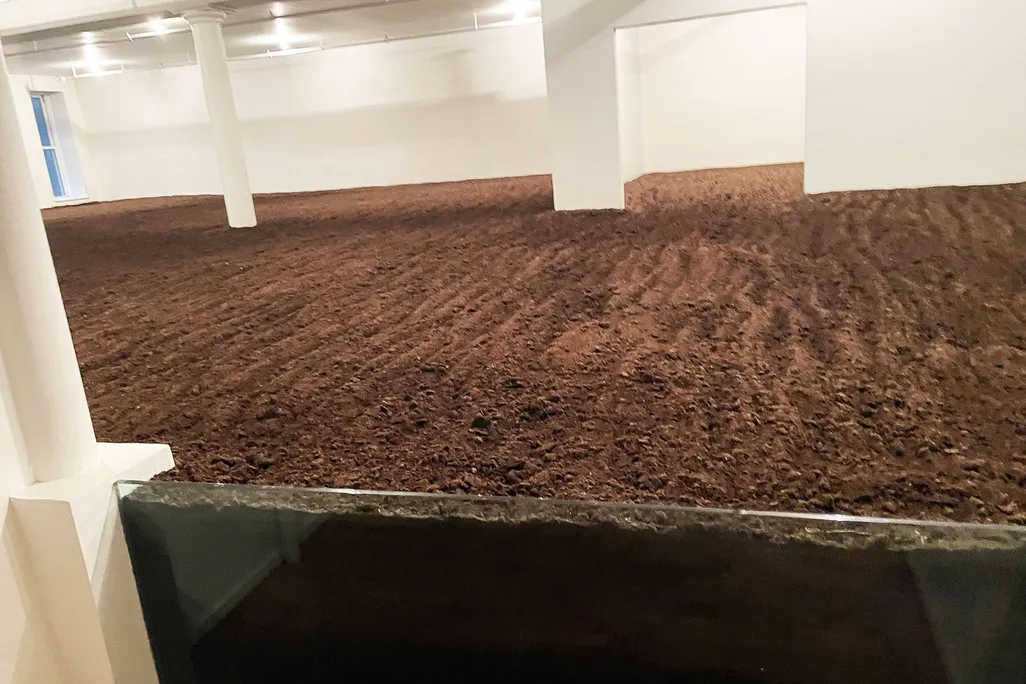New York City Loft Filled With 280,000 Pounds of Dirt Lives on After Death of Beloved Caretaker
Bill Dilworth, who died at age 70, had carefully maintained the curious art installation—known as “The New York City Earth Room”—and charmed visitors since 1989

In the heart of Manhattan’s SoHo neighborhood, a second-floor loft inside a former manufacturing building is covered with a two-foot-deep layer of dirt. The space is known as The New York Earth Room, and it has fascinated locals and tourists alike since its opening in 1977.
The installation, created by conceptual artist Walter De Maria, is known for its simplicity: 280,000 pounds of soil, evenly layered across several rooms spanning 3,600 square feet. Contrasted with the dirt’s deep brown hue, the loft’s bare walls create horizon lines that naturally draw onlookers’ curious gazes.
Quick fact: Is the soil in the Earth Room ever replaced?
Dilworth added soil when the dirt layer’s height decreased below the level that the artist had intended.Photographs are not permitted in the loam-scented space, and the sound of silence consumes the room’s visitors, who, as of 2016, tallied roughly 70 per day. Over the years, their stories have become intertwined with the room’s evolving lore.
“From the beginning, the Earth Room drew pilgrims, like the woman who visited a few decades ago and would stand silently for a bit and then start to laugh,” writes the New York Times’ Penelope Green. “Or the pre-med student who changed her major to soil studies after her first visit.”
While the concept is simple, the Earth Room is far from low maintenance. Since 1989, the space had been stewarded by Bill Dilworth, an abstract painter who died in December. Dilworth accepted the role of caretaker after seeing a photograph of the room, which continues to be overseen by the New York-based Dia Art Foundation.
/https://tf-cmsv2-smithsonianmag-media.s3.amazonaws.com/filer_public/89/0b/890b3434-9e28-4c75-bbe0-f250d2e56abd/gettyimages-2196270914.jpg)
“I was with my friend who was the building operations guy at Dia and he had to look at these pipes for something,” Dilworth told Artsy’s Sam Ashman in 2016. “Over my shoulder, I saw the guy at the desk here and afterwards I asked my friend Jim, ‘Does that job ever open up?’ And he said no. Two months later, it did.”
Dilworth, who was born in Detroit in 1954 and attended art school at Wayne State University, regularly watered and raked the Earth Room, maintaining the soil’s health. “Just to get it back to this moist state is gratifying to me, because this is the state that I relate to, that I maintained for decades,” Dilworth told the New Yorker’s Samantha Henig in 2023.
Sometimes he pulled weeds and mushrooms, which he claimed to have eaten.
Dilworth spent much of his day in a separate room adjacent to the installation, where he tallied the number of visitors in a notebook using a thick-edged black pen to inscribe markings that vaguely resembled the rest symbol in sheet music—perhaps fitting for the artist whom Jessica Morgan, the director of Dia, called the “most present man” she had ever met, per the Times.
In addition to his work at the Earth Room, Dilworth also made his living caring for the clock inside the Church of St. Teresa in Manhattan’s Lower East Side. Each week he climbed the tower, built in 1842, to wind it. According to the Times, his famed business cards read, “The Keeper of Earth and Time.”
Dilworth died of a stroke on December 10, though his death was not widely reported at the time. He had retired just several months earlier, and he spent the last few weeks of his Earth Room tenure by training his successor, Dana Avendano, a 28-year-old artist and Dia employee. During his final days on the job, he presented Avendano with a brand-new rake.
The artist De Maria described his Earth Room as an “interior earth sculpture,” and the exhibition is now in its third iteration. He opened the first two Earth Rooms in two German cities—Munich and Darmstadt—in 1968 and 1974, respectively. While neither still exist, the show in New York City is permanent.
In 2022, the Menil Collection in Houston, Texas, became the first United States museum to stage a solo exhibition on De Maria. Titled “Walter De Maria: Boxes for Meaningless Work,” the show included similar sprawling, conceptual installations such as “The 2000 Sculpture” and “The Vertical Earth Kilometer.”
Often, Dilworth was asked by visitors to explain the meaning behind the Earth Room. “It’s about earth, art and quiet,” Dilworth told the New Yorker. “People look at it, and they think nothing’s growing, and I say, ‘Look at it again, time is growing out there.’”
/https://tf-cmsv2-smithsonianmag-media.s3.amazonaws.com/accounts/headshot/ChristianThorsberg_Headshot.png)


